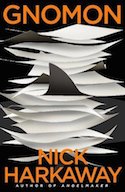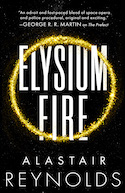Future Alternative Past: Sound it out
Every month, Nisi Shawl presents us with news and updates from her perch overlooking the world of science-fiction, fantasy, and horror. You can also look through the archives of the column.
Music of the spheres
Whenever I give an SFFH reading I also sing. And at their public readings, Pan Morigan and Andrea Hairston sing and play original songs inspired by Andrea’s novel Redwood and Wildfire.
No one knows how or why music so easily evokes emotions, but we three are certainly not above using it to do so. If I want people to long for an age yet to come I repurpose the lyrics of “Ode to Billy Joe” or rewrite a lullaby I learned off a Miriam Makeba record. Andrea, Pan, and I aim our skiffy at your earhole, and we’re not the only ones.
In fact, there’s a whole aesthetic movement, Afrofuturism, highlighting the connections between all Afrodiasporic art forms and speculative fiction. The musical groups Sun Ra Arkestra and Parliament-Funkadelic are foundational Afrofuturists: in the 1950s, Sun Ra traced his origins to Saturn; and Parliament-Funkadelic invoked a Mothership connection many a 1970s freakazoid knew in their alien(ated) heart to be true. Not just knee-deep, they were totally deep, and Jimi Hendrix’s homages to the genre range from the black magic fantasies of “Voodoo Child (Slight Return)” to his Philip José Farmer-inspired "Purple Haze." Michael Jackson’s songs provide a similarly wide spectrum: there’s the horror-evoking zombie menace in “Thriller” and the intergalactic love revolt of Captain Eo framing “Another Part of Me.” Prince not only read and sang speculative fiction, he embodied it. Present day Afrofuturists include Janelle Monae, who sings of androids, and Seattle DJ and author Gabriel Teodros, contributor to the anthology Octavia’s Brood and to CopperWire’s “hip-hop space opera” Earthbound.
And of course the intersection of SFFH and music extends beyond Afrofuturism. Certain of the lyrics to Steely Dan’s 1977 hit “Deacon Blues” derive from Alfred Bester’s classic SF novel The Demolished Man; the band’s name itself is taken from that of a dildo central to William S. Burroughs’s phantasmagoric Naked Lunch. David Bowie’s Ziggy Stardust metasaga explores the life of a glamrock star modeled on Bowie himself, and while it’s not strictly sfnal, it intimately concerns the ties between music and imaginative fiction. Which are everywhere, once you start looking: punk rocker Poly Styrene belting out “The Day the World Turned Dayglo,” Rocky Horror Picture Show’s Tim Curry exhorting us to do the Time Warp, Queen Bey calling for a ring to adorn her robot hand. Everywhere, musicians invoke SFFH.
And the reverse? Writers of SFFH inspired by music?
Early in my creative process I will often steal titles, settings, and incidents from songs — sometimes making off with entire plots, as when I lifted the storyline of a 16th century English ballad for “Cruel Sistah” (Later I wrote the lyrics to the blues my ghost sings at its climax).
A brief survey of my fellow social media addicts yielded dozens of similar anecdotes. Writers take inspiration where we can find it, from Television’s “Marquee Moon” (Stamping Butterflies by Jon Courtenay Grimwood) to Beethoven’s Ninth (“The Ninth Symphony of Ludwig Van Beethoven and Other Lost Songs” by Carter Scholz). Whole volumes are devoted to the concept, like Stars, a tribute anthology composed (hah!) of stories focused on specific Janis Ian songs.
SFFH authors put together playlists of music we listen to while writing particular stories; we write about instruments only nonhumans have the physical capability to play; we pen national anthems for imaginary countries and revolutionary hymns for nonexistent religions. We dance about extrasolar architecture.
Someone should probably write a book about it.
Recent books recently read

Marie Lu is best known for writing dystopian YA, but it’s not much of a leap from that subgenre to Batman: Nightwalker (Random House). Lu’s latest novel is full of urban grit and darkness, and at just-turning-18, Bruce Wayne’s appeal to Lu’s target audience couldn’t be more powerful. My high school sophomore niece said she hated me when I showed her my limited edition’s poster insert celebrating his hunkiness. At 62, I’m less vulnerable to those sorts of attractions, but the book’s first line hooked me: “The blood underneath her nails bothered her.” Ambiguously villainesque Madeleine Wallace is a perturbing and therefore appropriate opponent for a Bruce Wayne still battling the unacknowledged trauma of his parents’ recent death. Rich and isolated, gadget-loving and anti-authoritarian, Lu’s hero is a completely plausible adolescent version of comics’ favorite vigilante.

Nick Harkaway’s Gnomon (Knopf) combines, like Lu’s Batman, the self-sacrificing purity of an ethical investigator and a fascination with horizon-adjacent technology. And that’s about all the two books have in common. One is relatively straightforward, the equation to which a wave reduces; the other is as complex as the treasure-filled history of life beneath the sea. Broken-fingered Ethiopian artists; scheming, boastful, lovelorn math geniuses; and gigantic shark spirits roam the pages of Harkaway’s magnificent epic in hypnotically recursive patterns. Ostensibly it’s about the suspicious death of a dissident in a hyper-surveilled society, but there’s no way a mere synopsis or review can do Gnomon justice; the author himself admits that this book is too big to have ever fit in his all-too-human head. It must suffice simply to say that reading Gnomon will change you, and that afterwards you’ll be content with having changed.

Elysium Fire (Orbit) by Alastair Reynolds also occupies that sweet spot found between police procedurals and science fiction. A sequel to The Prefect, it pits the Panoply, a sort of omnipresent, laissez-faire police force, against an epidemic of inexplicable, brain-frying murders. 25th century civilization comprises thousands of habitats orbiting the planet Yellowstone, and constant, electronically-aided polling makes for a true democracy. Dogged by the climbing death rate and a rabble-rousing secessionist, Prefect Tom Dreyfus and operatives Thalia Ng and Sparver (a genetically enhanced pig) struggle to preserve the integrity of their far-flung beat. Their struggles would be stranger and yet more enjoyable if Reynolds’ accounts of inevitable social change kept up with his depictions of the high tech ubiquitous in this shimmering bubble of an outer space utopia. I didn't quite finish the novel by deadline. I'm going on with it now; I expect cool action, but no major cultural novelties.
Couple of upcoming cons
Looks like I’ll be giving the keynote speech next month at Amsterdam’s Other Future’s Festival. I highly suggest you get on over there, too. Other guests will includeNnedi Okorafor, the great Grace Dillon, and Wanuri Kahiu, director of the Kenyan science fiction film Pumzi. There’ll be music to listen to and movies to watch as well as talks to attend. Plus, you know, it’s in Amsterdam.
Closer to home, check out Escapade in Los Angeles, “The Slash Slumber Party!” Slash, in case you didn’t know, is fan-generated erotica pairing nominally het characters of the same sex: think Spock and Kirk nuzzling each other’s throats. Escapade’s also big on shipping and vids; shipping’s like slash with less of a homosexual mandate and a longer dramatic arc; and vids are fan-produced, music-coordinated, trailer-length films repurposing scenes from (usually) sfnal shows. Escapade features hours and hours of vidding premieres, uncensored.